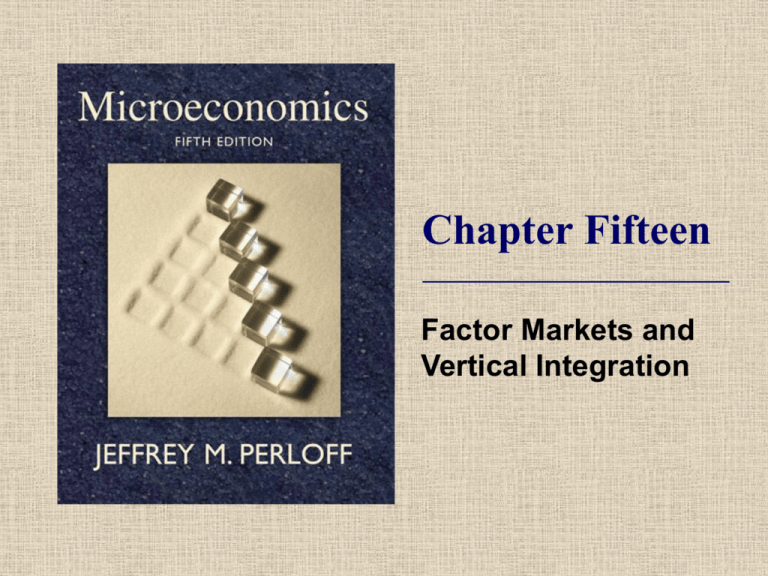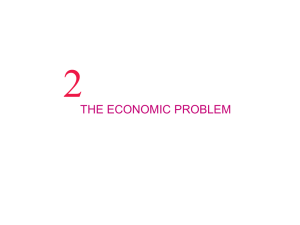
Chapter Fifteen
Factor Markets and
Vertical Integration
Topics
Competitive Factor Market.
Effect of Monopolies on Factor
Markets.
Monopsony.
Vertical Integration.
© 2009 Pearson Addison-Wesley. All rights reserved.
2
Introductory Definitions
vertically integrated - describing a firm
that participates in more than one
successive stage of the production or
distribution of goods or services.
monopsony - the only buyer of a good
in a given market.
© 2009 Pearson Addison-Wesley. All rights reserved.
3
Short-Run Factor Demand of a Firm
A profit-maximizing firm’s demand for a
factor of production is downward
sloping.
In the short run, a firm has a fixed
amount of capital:
K
and can vary the number of workers, L, it
employs.
© 2009 Pearson Addison-Wesley. All rights reserved.
4
Short-Run Factor Demand of a Firm
(cont).
marginal revenue product of labor
(MRPL) - the extra revenue from hiring
one more worker:
MRPL = MR . MPL
© 2009 Pearson Addison-Wesley. All rights reserved.
5
Short-Run Factor Demand of a Firm
(cont).
The firm maximizes its profit by hiring
workers until the marginal revenue
product of the last worker exactly equals
the marginal cost of employing that
worker, which is the wage:
MRPL = w
© 2009 Pearson Addison-Wesley. All rights reserved.
6
Short-Run Factor Demand of a Firm
(cont).
A competitive firm faces an infinitely
elastic demand for its output at the
market price, p, so:
MR = p
and
MRPL = p . MPL
© 2009 Pearson Addison-Wesley. All rights reserved.
7
Short-Run Factor Demand of a Firm
(cont).
The competitive firm hires labor to the point at
which:
MRPL = p . MPL = w
The wage line is the supply of labor the firm
faces.
The marginal revenue product of labor curve,
MRPL, is the firm’s demand curve for labor
© 2009 Pearson Addison-Wesley. All rights reserved.
8
Table 15.1 Marginal Product of Labor,
Marginal Revenue Product of Labor, and
Marginal Cost
© 2009 Pearson Addison-Wesley. All rights reserved.
9
(a) Labor Profit-Maximizing Condition
(b) Output Profit-Maximizing Condition
w, VMPL, $ per unit
MC, p, $ per unit
Figure 15.1 The Relationship Between
Labor Market and Output Market Equilibria
18
15
Labor supply
curve
w = 12
9
MRPL, Labor
demand curve
2
3
4
5
6
L, Workers per hour
© 2009 Pearson Addison-Wesley. All rights reserved.
MC
4
3
6
0
6
p
2.4
2
0
13
18
22 25 27
q, Units of output per hour
10
Profit Maximization Using Labor or
Output
The output profit-maximizing condition from
Chapter 8:
MC = p
is equivalent to the labor is equivalent to:
w
p
MC
MPL
© 2009 Pearson Addison-Wesley. All rights reserved.
11
w, VMPL, $ per unit
Figure 15.2 Shift of and Movement
Along the Labor Demand Curve
w1 = 12
D 1 = $3 ´ MPL
D2 = $2 ´ MPL
c
a
S1
8
b
w2 = 6
0
2
4
5
S2
6
L, Workers per hour
© 2009 Pearson Addison-Wesley. All rights reserved.
12
Solved Problem 15.1
How does a competitive firm adjust its
demand for labor when the government
imposes a specific tax of τ on each unit
of output?
© 2009 Pearson Addison-Wesley. All rights reserved.
13
Long-Run Factor Demand
In the long run, the firm may vary all of its
inputs.
The long-run labor demand curve takes account of
changes in the firm’s use of capital as the wage
rises.
© 2009 Pearson Addison-Wesley. All rights reserved.
14
Figure 15.3 Labor Demand of a
Thread Mill
© 2009 Pearson Addison-Wesley. All rights reserved.
15
Factor Market Demand
A factor market demand curve is the
sum of the factor demand curves of the
various firms that use the input.
To derive the labor market demand curve,
we first
determine the labor demand curve for each
output market and then
sum across output markets to obtain the factor
market demand curve.
© 2009 Pearson Addison-Wesley. All rights reserved.
16
The Marginal Revenue Product
Approach.
As the factor’s price falls, each firm,
taking the original market price as given,
uses more of the factor to produce more
output.
As the market price falls, each firm reduces
its output and hence its demand for the
input.
A fall in an input price causes less of an
increase in factor demand than would occur if
the market price remained constant
© 2009 Pearson Addison-Wesley. All rights reserved.
17
Figure 15.4 Firm and Market
Demand for Labor
© 2009 Pearson Addison-Wesley. All rights reserved.
18
An Alternative Approach.
For certain types of production
functions, it is easier to determine the
market demand curve by using the
output profit-maximizing equation rather
than the marginal revenue product
approach.
© 2009 Pearson Addison-Wesley. All rights reserved.
19
Figure 15.5 Demand for Microchips
in Calculators
© 2009 Pearson Addison-Wesley. All rights reserved.
20
Market Structure and Factor Demands
As we saw in Chapters 11 and 12,
MR = p(1 + 1/ε)
Thus, the firm’s marginal revenue product of labor
function is
1
MRPL p1 MPL
© 2009 Pearson Addison-Wesley. All rights reserved.
21
Figure 15.6 How Thread Mill Labor
Demand Varies with Market Structure
© 2009 Pearson Addison-Wesley. All rights reserved.
22
A Model of Market Power in Input and
Output Markets
The inverse demand, p(Q), for the final
good is
p = 80 − Q.
© 2009 Pearson Addison-Wesley. All rights reserved.
23
A Model of Market Power in Input and
Output Markets
The marginal product of labor is 1
because one extra worker produces one
more unit of output. Thus,
MRPL = p . MPL = p,
The labor demand function is the same as
the output demand function,
w = 80 − L.
© 2009 Pearson Addison-Wesley. All rights reserved.
24
Figure 15.7 Effect of Output Market
Structure on Labor Market Equilibrium
© 2009 Pearson Addison-Wesley. All rights reserved.
25
Competitive Factor Market and
Monopolized Output Market.
The monopoly’s marginal revenue curve is twice as
steep as the linear output demand curve it faces
(Chapter 11):
MRQ = 80 − 2Q
The monopoly maximizes its profit where:
MRQ = 80 − 2Q = 20 = MC
And because the monopoly’s marginal product of labor is 1, its
demand curve for labor equals its marginal revenue curve:
MRPL = MRQ . MPL = MRQ
© 2009 Pearson Addison-Wesley. All rights reserved.
26
Competitive Factor Market and
Monopolized Output Market (cont).
We obtain its labor demand function by
replacing Q with L and MRQ with w in its
marginal revenue function:
w = 80 − 2L
A monopoly hurts final consumers and
drives some sellers of the factor (workers)
out of this market.
© 2009 Pearson Addison-Wesley. All rights reserved.
27
Monopolized Factor Market and
Competitive Output Market.
Now suppose that the output market is
competitive and that there is a labor
monopoly.
One possibility is that the workers form a union that
acts as a monopoly.
Because the competitive output market’s labor
demand curve is the same as the output
demand curve,
MRL = 80 − 2L.
© 2009 Pearson Addison-Wesley. All rights reserved.
28
Application Union Monopoly Power
© 2009 Pearson Addison-Wesley. All rights reserved.
29
Monopoly in Successive Markets.
If the labor and output markets are both
monopolized, consumers get hit with a
double monopoly markup.
© 2009 Pearson Addison-Wesley. All rights reserved.
30
Figure 15.8 Double Monopoly Markup
© 2009 Pearson Addison-Wesley. All rights reserved.
31
Solved Problem 15.2
How are consumers affected and how
do profits change in the example if the
labor monopoly buys the monopoly
producer (integrates vertically)?
© 2009 Pearson Addison-Wesley. All rights reserved.
32
Monopsony
A monopsony chooses a price-quantity
combination from the industry supply
curve that maximizes its profit.
© 2009 Pearson Addison-Wesley. All rights reserved.
33
Monopsony Profit Maximization
Suppose that a firm is the sole employer
in town.
marginal expenditure – the additional cost
of hiring one more worker
depends on the shape of the supply curve.
© 2009 Pearson Addison-Wesley. All rights reserved.
34
Figure 15.9 Monopsony
© 2009 Pearson Addison-Wesley. All rights reserved.
35
Monopsony Profit Maximization (cont).
Any buyer buys labor services up to the
point at which the marginal value of the
last unit of a factor equals the firm’s
marginal expenditure.
Monopsony power - the ability of a
single buyer to pay less than the
competitive price profitably.
© 2009 Pearson Addison-Wesley. All rights reserved.
36
Monopsony Profit Maximization (cont).
The markup of the marginal expenditure
(which equals the value to the monopsony)
over the wage is inversely proportional to the
elasticity of supply at the optimum
MR w 1
w
© 2009 Pearson Addison-Wesley. All rights reserved.
37
Application Company Towns
© 2009 Pearson Addison-Wesley. All rights reserved.
38
Welfare Effects of Monopsony
By creating a wedge between the value
to the monopsony and the value to the
suppliers, the monopsony causes a
welfare loss in comparison to a
competitive market.
© 2009 Pearson Addison-Wesley. All rights reserved.
39
Figure 15.10 Welfare Effects of
Monopsony
© 2009 Pearson Addison-Wesley. All rights reserved.
40
Solved Problem 15.3
How does the equilibrium in a labor
market with a monopsony employer
change if a minimum wage is set at the
competitive level?
© 2009 Pearson Addison-Wesley. All rights reserved.
41
Solved Problem 15.3
© 2009 Pearson Addison-Wesley. All rights reserved.
42
Monopsony Price Discrimination
If some consumers have monopsony
power while others do not, sellers offer
those with monopsony power lower
prices.
A monopsony may directly price
discriminate in much the same way as a
monopoly or an oligopoly.
© 2009 Pearson Addison-Wesley. All rights reserved.
43
Vertical Integration
To sell a good or service to consumers
involves many sequential stages of
production and sales activities.
Profitability determines how many stages a
firm performs itself.
© 2009 Pearson Addison-Wesley. All rights reserved.
44
Figure 15.11 Vertical Organization
© 2009 Pearson Addison-Wesley. All rights reserved.
45
Degree of Vertical Integration
A firm that participates in more than one
successive stage of the production or
distribution of goods or services is
vertically integrated.
A firm may vertically integrate backward
and produce its own inputs.
© 2009 Pearson Addison-Wesley. All rights reserved.
46
Degree of Vertical Integration (cont).
Contractual vertical restraints – when a
firms control the actions of the firms with
whom they deal by writing contracts that
restrict the actions of those other firms.
Such tight relationships between firms are
referred to as quasi-vertical integration.
© 2009 Pearson Addison-Wesley. All rights reserved.
47
Produce or Buy
Five possible benefits from vertical
integration are:
lowering transaction costs,
ensuring a steady supply,
avoiding government intervention,
extending market power to another market,
and
eliminating market power.
© 2009 Pearson Addison-Wesley. All rights reserved.
48
Lowering Transaction Costs.
transaction costs - the costs of trading with
others besides the price, including the costs of
writing and enforcing contracts.
opportunistic behavior - taking advantage of
someone when circumstances permit.
asymmetric information - the
knowledgeable firm may take advantage of
the relatively ignorant firm.
© 2009 Pearson Addison-Wesley. All rights reserved.
49
Ensuring a Steady Supply.
just-in-time - system of having
suppliers deliver inputs at the time
needed to process them, thus
minimizing inventory costs and avoiding
bottlenecks.
© 2009 Pearson Addison-Wesley. All rights reserved.
50
Avoiding Government Intervention.
A vertically integrated firm avoids price
controls by selling to itself.
Firms also integrate to lower their taxes
© 2009 Pearson Addison-Wesley. All rights reserved.
51
Extending Market Power.
By vertically integrating, a firm may be
able to increase its monopoly profits by
price discriminating or by monopolizing.
© 2009 Pearson Addison-Wesley. All rights reserved.
52






